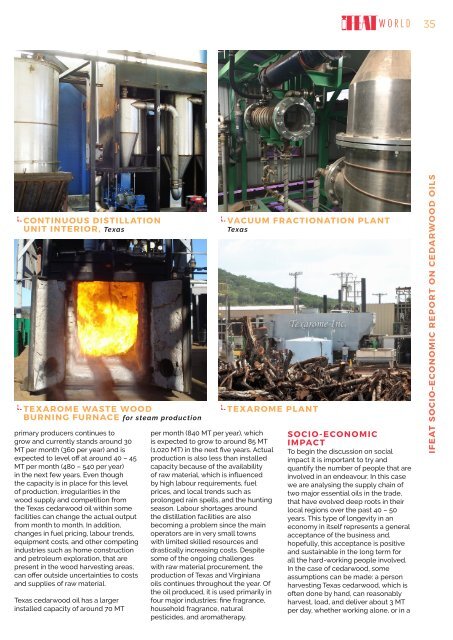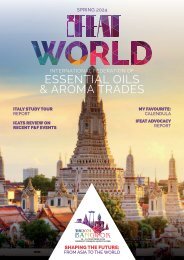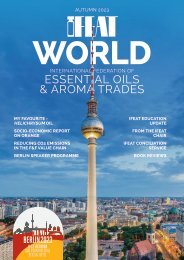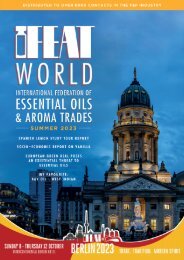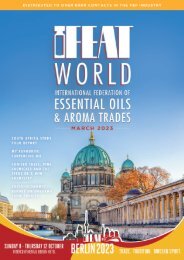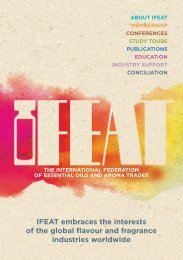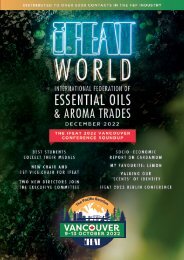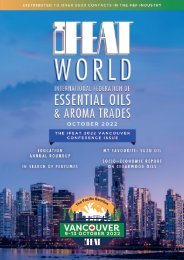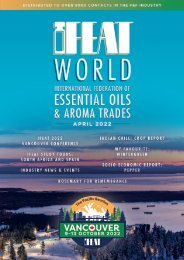IFEATWORLD July 2022
A Members' Newsletter for the International Federation of Essential Oils & Aroma Trades.
A Members' Newsletter for the International Federation of Essential Oils & Aroma Trades.
Create successful ePaper yourself
Turn your PDF publications into a flip-book with our unique Google optimized e-Paper software.
WORLD 35<br />
CONTINUOUS DISTILLATION<br />
UNIT INTERIOR, Texas<br />
TEXAROME WASTE WOOD<br />
BURNING FURNACE for steam production<br />
primary producers continues to<br />
grow and currently stands around 30<br />
MT per month (360 per year) and is<br />
expected to level off at around 40 – 45<br />
MT per month (480 – 540 per year)<br />
in the next few years. Even though<br />
the capacity is in place for this level<br />
of production, irregularities in the<br />
wood supply and competition from<br />
the Texas cedarwood oil within some<br />
facilities can change the actual output<br />
from month to month. In addition,<br />
changes in fuel pricing, labour trends,<br />
equipment costs, and other competing<br />
industries such as home construction<br />
and petroleum exploration, that are<br />
present in the wood harvesting areas,<br />
can offer outside uncertainties to costs<br />
and supplies of raw material.<br />
Texas cedarwood oil has a larger<br />
installed capacity of around 70 MT<br />
per month (840 MT per year), which<br />
is expected to grow to around 85 MT<br />
(1,020 MT) in the next five years. Actual<br />
production is also less than installed<br />
capacity because of the availability<br />
of raw material, which is influenced<br />
by high labour requirements, fuel<br />
prices, and local trends such as<br />
prolonged rain spells, and the hunting<br />
season. Labour shortages around<br />
the distillation facilities are also<br />
becoming a problem since the main<br />
operators are in very small towns<br />
with limited skilled resources and<br />
drastically increasing costs. Despite<br />
some of the ongoing challenges<br />
with raw material procurement, the<br />
production of Texas and Virginiana<br />
oils continues throughout the year. Of<br />
the oil produced, it is used primarily in<br />
four major industries: fine fragrance,<br />
household fragrance, natural<br />
pesticides, and aromatherapy.<br />
VACUUM FRACTIONATION PLANT<br />
Texas<br />
TEXAROME PLANT<br />
SOCIO-ECONOMIC<br />
IMPACT<br />
To begin the discussion on social<br />
impact it is important to try and<br />
quantify the number of people that are<br />
involved in an endeavour. In this case<br />
we are analysing the supply chain of<br />
two major essential oils in the trade,<br />
that have evolved deep roots in their<br />
local regions over the past 40 – 50<br />
years. This type of longevity in an<br />
economy in itself represents a general<br />
acceptance of the business and,<br />
hopefully, this acceptance is positive<br />
and sustainable in the long term for<br />
all the hard-working people involved.<br />
In the case of cedarwood, some<br />
assumptions can be made: a person<br />
harvesting Texas cedarwood, which is<br />
often done by hand, can reasonably<br />
harvest, load, and deliver about 3 MT<br />
per day, whether working alone, or in a<br />
IFEAT SOCIO–ECONOMIC REPORT ON CEDARWOOD OILS


